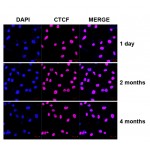| Reactivity: | Human, Mouse, Rat |
| Applications: | WB, IF/IC, ELISA |
| Host Species: | Rabbit |
| Isotype: | IgG |
| Clonality: | Polyclonal antibody |
| Gene Name: | cystatin C |
| Gene Symbol: | CST3 |
| Synonyms: | ARMD11; HEL-S-2; Cystatin C |
| Gene ID: | 1471 |
| UniProt ID: | P01034 |
| Immunogen: | Recombinant fusion protein containing a sequence corresponding to amino acids 1-146 of human Cystatin C (NP_000090.1). |
| Dilution: | WB 1:500-1:2000; IF/IC 1:10-1:100 |
| Purification Method: | Affinity purification |
| Concentration: | 0.58 mg/ml |
| Buffer: | Buffer: PBS with 0.02% sodium azide,50% glycerol,pH7.3. |
| Storage: | Store at -20°C. Avoid freeze/thaw cycles. |
| Documents: | Manual-CST3 antibody |
Background
The cystatin superfamily encompasses proteins that contain multiple cystatin-like sequences. Some of the members are active cysteine protease inhibitors, while others have lost or perhaps never acquired this inhibitory activity. There are three inhibitory families in the superfamily, including the type 1 cystatins (stefins), type 2 cystatins and the kininogens. The type 2 cystatin proteins are a class of cysteine proteinase inhibitors found in a variety of human fluids and secretions, where they appear to provide protective functions. The cystatin locus on chromosome 20 contains the majority of the type 2 cystatin genes and pseudogenes. This gene is located in the cystatin locus and encodes the most abundant extracellular inhibitor of cysteine proteases, which is found in high concentrations in biological fluids and is expressed in virtually all organs of the body. A mutation in this gene has been associated with amyloid angiopathy. Expression of this protein in vascular wall smooth muscle cells is severely reduced in both atherosclerotic and aneurysmal aortic lesions, establishing its role in vascular disease. In addition, this protein has been shown to have an antimicrobial function, inhibiting the replication of herpes simplex virus. Alternative splicing results in multiple transcript variants encoding a single protein.
Images
 | Western blot analysis of lysates from Hep G2 cells, using Cystatin C Rabbit pAb (A1561) at 1:700 dilution. Secondary antibody: HRP-conjugated Goat anti-Rabbit IgG (H+L) (AS014) at 1:10000 dilution. Lysates/proteins: 25μg per lane. Blocking buffer: 3% nonfat dry milk in TBST. Detection: ECL Basic Kit (RM00020). Exposure time: 30s. |
 | Immunofluorescence analysis of HeLa cells using Cystatin C Rabbit pAb (A1561). Secondary antibody: Cy3-conjugated Goat anti-Rabbit IgG (H+L) (AS007) at 1:500 dilution. Blue: DAPI for nuclear staining. |
You may also be interested in:

